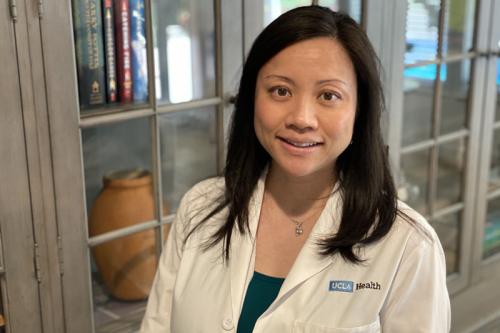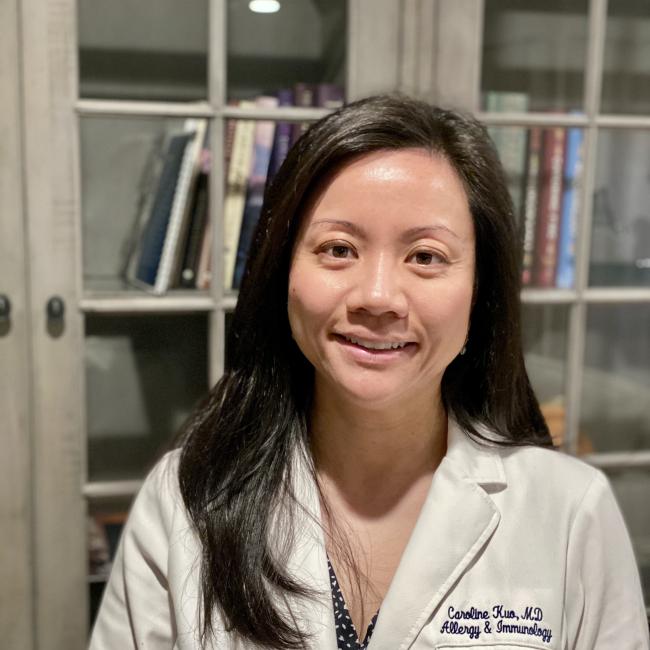
UCLA researcher receives CIRM award to compare gene therapy techniques to treat DOCK8 deficiency
Dr. Caroline Kuo, a member of the Eli and Edythe Broad Center of Regenerative Medicine and Stem Cell Research at UCLA, has received a $234,000 grant from the California Institute for Regenerative Medicine, the state’s stem cell agency.
Kuo, who is an assistant clinical professor of pediatrics in the division of allergy, immunology, and rheumatology and runs her own immunology clinic, specializes in research involving the detection and treatment of immune system deficiencies and recurrent infections in pediatric and adult patients.
Kuo was invited to apply for this new “Progression” grant based on her success moving another CIRM-funded discovery stage project – developing a stem cell gene therapy for a deadly immunodeficiency called X-linked hyper IgM syndrome – to the translational phase. Kuo first received funding to develop a treatment for X-linked hyper IgM syndrome from CIRM in 2017. This work has gone so well that Kuo and her team are now preparing the pre-clinical work needed to launch a clinical trial.
While Kuo continues to work on her treatment for X-linked hyper IgM syndrome, this new grant will allow her to launch a new research project: Comparing two gene therapy techniques as potential treatments for a different immunodeficiency, called autosomal recessive hyper IgE syndrome, also known as DOCK8 deficiency.
This condition is caused by a mutation in the DOCK8 gene, which produces a protein called DOCK8. This protein regulates the function of another protein called actin, which is vital for the movement and interaction of cells, including those involved in the immune response.
Children and adults suffering from DOCK8 deficiency are more susceptible to viral, bacterial and fungal infections, particularly of the skin. People with DOCK8 deficiency also commonly suffer from autoimmune diseases, asthma and allergies and are highly susceptible to cancer. More than 95% of patients with DOCK8 deficiency die by age 40.
Kuo said her experience treating patients with DOCK8 deficiency inspired her to take up the challenge of finding a new treatment.
“I wanted to research new treatment options for DOCK8 deficiency because I see how debilitating it can be for my patients,” said Kuo. “It’s already bad enough that my patients feel sick but then add to that visible skin infections on their hands and face that are difficult to treat, I think that’s the hardest part for a lot of the children I see.”
“The prospect of developing a curative therapy for patients definitely brings a lot more meaning to the work,” she added.
Gene therapies are a new class of treatments that correct genetic disorders by modifying the genes inside of a patient’s own cells. Gene therapies for blood and immune disorders commonly use blood-forming stem cells, which can self-renew and give rise to all of the cells that make up the blood and immune system. These blood-forming stem cells are removed from the patient, genetically corrected and then infused back into the patient where they will self-renew and create a continual supply of healthy blood and immune cells. The ability to correct the genetic disorder using the patient’s own cells effectively means the patient is his or her own cell donor and avoids the risk of transplant rejection.
The genetic correction can be accomplished through gene editing, in which the diseased gene sequence is corrected, or traditional gene therapy, in which a healthy version of the gene is simply added into the DNA sequence. Kuo and her frequent collaborator Dr. Donald Kohn, a UCLA Broad Stem Cell Research Center member and distinguished professor of microbiology, immunology and molecular genetics, have had success treating other immune deficiencies — bubble baby disease and X-linked chronic granulomatous disease — with traditional gene therapy methods.
However, DOCK8 deficiency may require a different approach due to the large size of the DOCK8 gene.
“In traditional gene therapy, we package the replacement gene in a modified virus that is capable of getting right into the nucleus of the cell,” Kuo said. “However, we just don’t know if that will work with a large gene that is so much harder to package.”
To determine the best approach to treat DOCK8 deficiency, Kuo will compare traditional gene therapy methods with the CRISPR-Cas9 platform. Adapted from a naturally occurring immune reaction that bacteria use to fight viruses, CRISPR/Cas9 relies on a scissor-like protein called Cas9, which can be directed to cut DNA at specific sites on a cell’s genome to disable, repair or make other alterations to genes.
“Gene editing with CRISPR is appealing because it is so precise,” said Kuo. “But anything that is more precise is also more challenging.”
Kuo hopes that if she can demonstrate that either of these methods can effectively treat DOCK8 deficiency, it could pave the way for new treatments for other conditions brought on by mutations to large genes.
“If we can successfully demonstrate a way to get around the problem of editing or replacing large genes, there are many, many other diseases this could help with,” she said.
